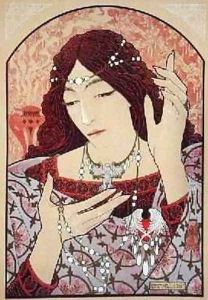Jules Marcel-Lenoir Paintings
Jules Marcel-Lenoir, born Jules Lenoir in 1872, was a French artist whose work spans a range of styles but is most closely associated with the Symbolist movement. Despite not being as widely recognized as some of his contemporaries, Marcel-Lenoir's contributions to late 19th and early 20th-century art provide a unique blend of mysticism, medievalism, and modernity, reflecting the diverse influences and artistic explorations of his time. His artistic output includes paintings, murals, and illustrations that often explore themes of spirituality, mythology, and allegory, imbued with a deep sense of the sacred and the profane.
After receiving his initial training in art, Marcel-Lenoir's career was marked by a passionate commitment to integrating art into everyday life, an idea that was gaining popularity among avant-garde artists and thinkers of his era. He was inspired by the Arts and Crafts Movement and sought to break down the barriers between fine arts and decorative arts. His work was not only limited to canvas but also included stained glass and mosaics, showcasing his versatility and his desire to make art accessible and integral to public and private spaces.
Throughout his career, Marcel-Lenoir was involved in various artistic circles and collaborated with writers, musicians, and other artists, contributing to the rich cultural tapestry of early 20th-century France. His works were exhibited in several notable venues, and he participated in exhibitions that helped to define the era's artistic trends. Despite his artistic achievements, Marcel-Lenoir's name has not endured as prominently as some of his peers, partly due to the eclectic nature of his work and his focus on spiritual and mystical themes, which fell out of favor in the rapidly changing art world of the post-World War I period.
Marcel-Lenoir's legacy, however, has seen a resurgence of interest in recent years, with art historians and collectors revisiting his contributions to symbolist and early modern art. His work is now recognized for its innovative approach to form and content, as well as its influence on the development of art nouveau and modernist movements. Jules Marcel-Lenoir died in 1947, leaving behind a body of work that continues to inspire and captivate those who seek to explore the depths of symbolist art and its impact on the evolution of modern artistic expressions.
